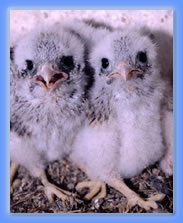Orphaned or Injured
It is very common for people to find young raptors in the spring or summer that they mistakenly think are orphaned from their parents. In most cases the young raptor has merely unsuccessfully attempted to fly or fluttered down from its nest or perch.
Almost always the parents are aware of its location and will continue to feed it until it is strong enough to fly, if it is left alone. So, in most cases it is not wise to try to move what appears to be an orphaned raptor. By watching the young raptor from a distance, the parents presence and interest can almost always be observed. Usually the only assistance it may need, if it is in danger on the ground from predators, is to be helped to a low branch, tree crotch, or even a flat (shaded) shed roof. It is advisable to call your local Ohio Division of Wildlife Headquarters, County Wildlife Officer or wildlife rehabilitator for assistance (see links below) with this, as even young raptors can inflict serious wounds with their beaks and talons and sometimes territorial parents may attack.
If you find a raptor that appears to be injured or diseased please call your local Ohio Division of Wildlife Headquarters, County Wildlife Officer or licensed wildlife rehabilitator. Drooping wings, inability to fly, disorientation, gaping mouths, and lacerated feet are just a few of the outward signs that a raptor is sick or injured.
Caring for injured birds requires a Special Purpose Permit issued by your State and the U.S. Fish & Wildlife Service. Captive Breeding and Release also requires a Special Permit, and selling Raptors to non-licensed individuals is illegal. Not all Ohio wildlife rehabilitators are authorized to care for raptors.
Lost Raptors
Occasionally a falconry bird may be lost during a hunt. If this happens, the falconer will make every attempt to retrieve the hawk. If these attempts fail the hawk may simply fly off and go back to surviving on its own (this is especially true of hawks that were initially taken from the wild). In some cases, the hawk may be the offspring of captive-raised parents and may not have the needed experience to survive on its own. In either case, the falconer will certainly be trying to locate it. Sometimes lost hawks may stray many miles (even hundreds) from where they were lost.
Tell-tale signs that a hawk is a lost falconry bird is the presence of nylon or leather jesses on its legs (usually there is one on each leg) that dangle when it flies or perches. There may also be a bell on one or both legs that jingle when the bird is in flight. All falconry hawks will have a metal or plastic band on one leg. Some will have a small I.D. tag with a falconer’s phone number. In some instances a small transmitter with a short wire antenna may dangle from a leg or off the hawk’s tail. Sometimes the hawk may show an uncanny toleration of humans or may appear to be hanging around looking for an easy meal.
If you think you have sighted a lost hawk in your vicinity please contact us at losthawk@ohiofalconry.org and we will get the word out to Ohio falconers and those in surrounding states. Any descriptive information and/or pictures you have will be helpful.

